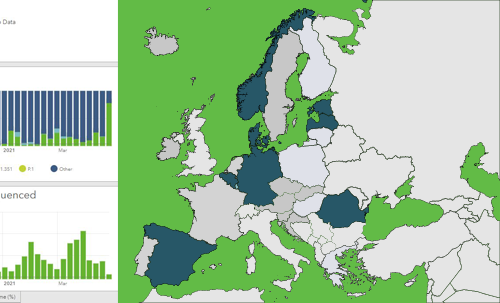
How to read and interpret the data
Where data for a country are available from more than one source, the default source used is the one with the highest number of sequences in the last two weeks.
Data for the most recent reporting week have been excluded, as they may be incomplete.
Categories used for sequencing volume are based on the sample selection guidance provided in ECDC’s technical guidance for sequencing of SARS-CoV-2 and its guidance for representative and targeted genomic SARS-CoV-2 monitoring:
- ≥500 or ≥10% of cases: 500 or more, or at least 10% of all samples sequenced, by week; if samples are randomly selected, it is possible to follow trends and to estimate the distribution of variants. Higher numbers would increase the accuracy and allow the detection of variants accounting for a smaller proportion of circulating viruses.
- 60-499: Above 60 but below 500 sequenced samples by week. If samples are randomly selected, it is possible to detect a variant accounting for more than 2.5% of all circulating variants and to follow trends, but estimating variants distribution would be inaccurate.
- <60: Under 60 selected samples by week, a specific variant would have to account for at least 5% of all circulating viruses to be detected, if sampling is performed in a random and representative manner. This means that the system will have a poor ability to detect circulating variants of concern before they have an impact on the overall epidemiological situation.
How to use the dashboard:
Select the week number to filter maps and the variant distribution graph.
Select the country to filter both graphs.
The whole dashboard can be filtered to show only data when sequencing volumes were above those recommended by ECDC (>=500 sequences or >=10% of cases sequenced in a specific week) by clicking on “configure sources manually” and using the “source” filter (top-right) to switch sources.
Limitations:
As not all generated sequences are reported, underestimates of the sequencing activities in some countries might occur. Please see the country overview report for additional limitations.
The proportion of variants is only reliable when sequencing capacity is adequate (≥500 or ≥10% of total samples). Even then, estimates must be treated with caution since they may be biased if the sequenced viruses are not representative of all cases in the country. For TESSy data, no proportion of variants has been estimated where there is no reliable denominator available.
Background information
Since the discovery of SARS-CoV-2, three variants of concern, first identified in the United Kingdom (B.1.1.7), South Africa (B.1.351), and Brazil (P.1), have been associated with higher transmissibility and severity of disease, with potential implications for acquired immunity or the effectiveness of current vaccines. In addition, SARS-CoV-2 lineages B.1.617.1, B.1.617.2, and B.1.617.3, first reported in India in December 2020, have been increasingly detected in other countries.
Follow this news feed: EU





